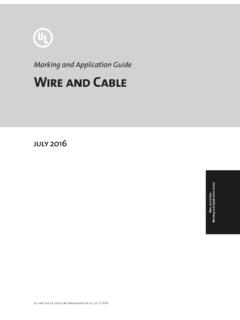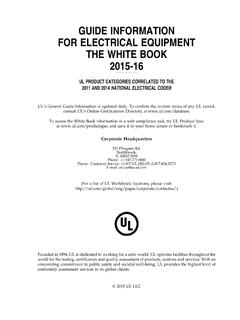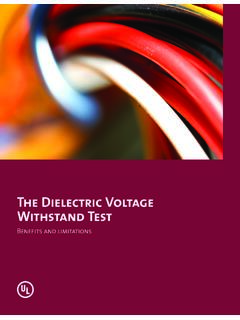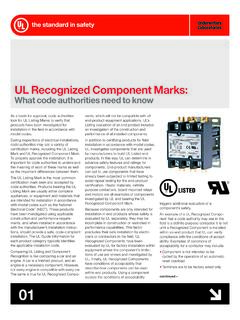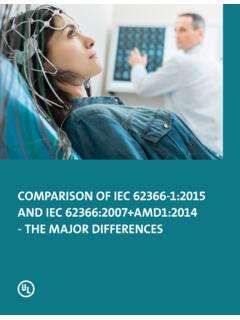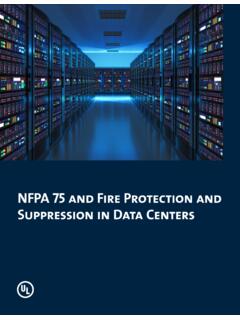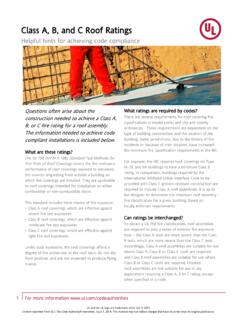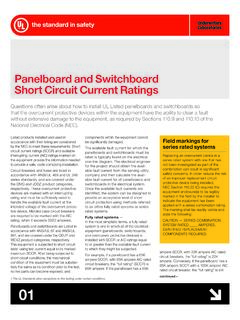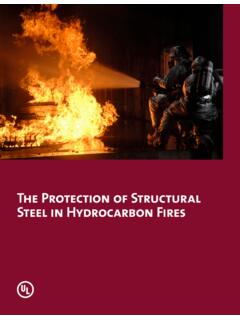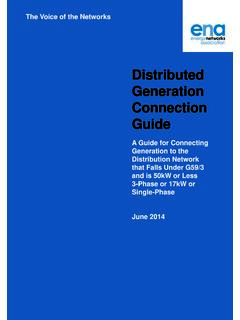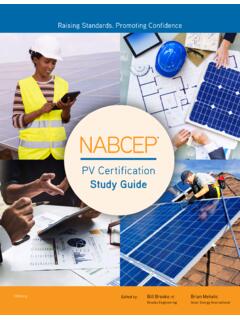Transcription of IEC 61730 2ND EDITION - UL
1 Page 1 The Dawn of New PV Safety Requirements: IEC 61730 2ND EDITION page 2 The international standards for photovoltaic (PV) module safety qualification, IEC 61730 series ( 61730 -1 and 61730 -2), were recently updated to reflect changes in PV module technologies. Published in 2016, the new second EDITION relies on the important and fundamental concepts from IEC horizontal standards, in particular, the IEC 60664 series. This standard series defines and uses the concepts of insulation coordination and, in combination with IEC 61140, defines application classes that apply to PV modules.
2 Both IEC 60664 and IEC 61140 include requirements regarding the coordination of insulation systems. These include internal and external factors such as material groups, installation type, location of the installation, pollution degree, system voltages and overvoltages. The new material and component requirements in the updated IEC 61730 standards were derived from those in IEC 60664 and IEC 61140, which have been successfully used in connection with standards for other electrical equipment. This also helped to develop the fundamental understanding of 1500 V DC components and the materials used in the construction of PV modules.
3 New concepts are included in the IEC 61730 revisions, like distance through insulation and cemented joints. These new concepts are ideal for further development of PV modules and will help support the expanded deployment of PV-based solar panel systems. This paper will review the specifics of these 3 INTRODUCTION The worldwide installed photovoltaic capacity reached over 220 gigawatt peak (GWp) in 2015, and is expected to grow to more than 500 GWp by the year While the installation of small (about 1 kilowatt [kW] 20 kW) rooftop PV systems still constitutes a significant portion of the overall market, the trend in today s PV systems is moving toward medium (about 100 kW 1 megawatt [MW]) and larger scale (greater than 1MW) installations, with some installations even reaching the 1 gigawatt (GW)
4 Level. This trend is being driven in large part by the economics of PV system design. Average PV module sales prices have decreased to around USD per watt peak (Wp). At the same time, other balance of system (BOS) costs, such as labor and cabling, now constitute a greater portion of the total installed cost of a PV system. As a result, system designers are focusing increased attention on systems that support higher voltages in the 1000-1500 volt (V) range, and adopting a more comprehensive approach to system development planning. Higher voltage PV systems use less current, allowing for smaller conductor diameters throughout the system and further reducing electrical system losses.
5 However, higher DC voltages also constitute new challenges for PV system component designs and materials that need to be addressed in the applicable standards. As such, these standards must remain technologically up to date to address essential safety requirements for evolving products and , IEC 61730 -1, Photovoltaic (PV) module safety qualification Part 1: Requirements for construction, and IEC 61730 -2, Photovoltaic (PV) module safety qualification Part 2: Requirements for testing, have been revised to include clear requirements developed for system voltages of up to 1500 V, including more stringent material and spacing requirements to reflect elevated operating voltages.
6 Based on PV module design, used concepts and utilized materials, the new standards will also help to promote further module innovation that will not only drive down module price per watt but also overall system 4 BACKGROUNDThe first international standard governing minimum construction requirements for the safety of PV modules was the first EDITION of IEC 61730 , published in 2004. Prior national standards were based on commonly observed field failure modes, most prominently those observed during the Flat-Plate Solar Array (FSA) project, sponsored by the National Aeronautics and Space Administration (NASA) and conducted by the California Institute of Technology s Jet Propulsion Laboratory (JPL) between 1975 and ,3 The main focus was on crystalline silicon (c-Si) PV modules with solar cells of typically 500 m thickness.
7 UL 1703, The Standard for Flat-Plate Photovoltaic Modules and Panels, was largely based on the JPL s block-buy module development and test experience. UL 1703 then led to the development of the first EDITION of the IEC 61730 to supplement the type approval standards IEC 61215, Terrestrial photovoltaic (PV) modules Design qualification and type approval Part 1: Test requirements, and IEC 61646, Thin-film terrestrial photovoltaic (PV) modules Design qualification and type approval (Essential elements of IEC 61646 were merged into the latest EDITION of IEC 61215, and IEC 61646 was withdrawn in 2016).
8 4 Advancements in PV technology, along with actual experience in the use of the original versions of the first EDITION of IEC 61730 , prompted the need for a revised version of both standards. The new second editions of the standards were developed over a period of more than eight years with significant contributions from UL and industry participants. Figure 1, on page 5, illustrates the development timeline of the new EDITION of IEC 61730 with the original versions of the IEC 61730 , the two parts of the series work in conjunction with each other. Part 1 details the construction and component requirements for individual applications, while Part 2 provides safety testing requirements to verify which materials are being used, how they are integrated into the PV module specific design, and how the design is produced into a finished module.
9 The revised standards also eliminate overlapping and duplication of requirements that characterized the original versions, such as some testing requirements formerly found in Part 1. The revised standards are now also closely aligned with the recently revised IEC 61215 Standards. For example, several of the tests in the revised IEC 61730 Standards are identical to those in the revised IEC 61215 series, and failure modes and requirements are similar for both performance and safety aspects. However, the IEC 61730 places greater emphasis on safety aspects related to protection against electric shock, as well as fire 5 Figure 1: Summarized timeline of the development stages of IEC 61730 -1 and IEC 61730 -2It is important to note that PV module components can t be assessed in isolation from the rest of a PV module.
10 Any changes in a module s bill of material (BOM) requires a further technical assessment to assess any potential impacts associated with the change, including unanticipated interactions between module materials. A detailed retesting guidance document, currently identified as IEC/TS 62915, is under development and is expected to reference any retesting requirements under IEC 61215 and IEC 61730 when changes are of First Edition2009 First Technical Proposal for Two Editions2011 Amendment 1 For 1st EditionEnd of 2011 Distribution of Proposal for 2nd EditionJan 2012 Proposal Not AcceptedMar 2013 Amendment 2 for 1st EditionFeb 2013 Formation of a Task Force Group to Issue Draft Proposal for 2nd EditionMay 2013 First Presentation of TF-G-Proposal to IEC-Group TC82 WG2 Oct 2013 Presentation of 1st DraftJan 2014 Publication of IEC 61730 -1 Ed.
